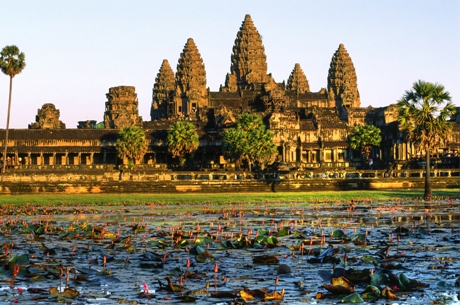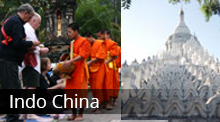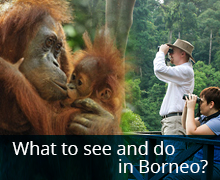REP54PNH – 5D4N Siem Reap & Phnom Penh Tour
Adult: RM 783 | Child: RM 0
This tour combination of Siem Reap and a brief visit to Phnom Penh covers all highlights of the Cambodian history both in awe and horror. Having emerged from decades of civil war and general unrest the Khmer people are incredibly welcoming and warm and will be a highlight of your stay.

DAY 1 ARRIVE SIEM REAP
Upon arrival in Siem Reap International Airport at morning time, you will be welcome by our guide and driver and then transfer you to hotel for check in.
We visit the immense walled city Angkor Thom that was the masterpiece of King Jayavarman VII. Following the occupation of Angkor by the Chams from 1177 to 1181, the new king decided to build an impregnable fortress at the heart of his empire. The scale is simply staggering and we are immediately overwhelmed by the audacity of Jayavarman on arrival at the city’s gates. The causeway is lined by an intricate bridge depicting the Churning of the Ocean of Milk from Hindu mythology in which the devas (gods) and asuras (devils) play tug of war with a naga (seven-headed serpent) to obtain the elixir of immortality.
We begin our visit at the Terrace of the Leper King. This intricately carved platform was the royal crematorium and the statue that was originally thought to be the leper king is now believed to be Yama, the god of death. We continue along the Terrace of Elephants, originally used as a viewing gallery for the king to preside over parades, performances and traditional sports. At the southern end lies the Baphuon, once of the most beautiful temples at Angkor, dating from the reign of Uditayavarman in the 11th century. It has undergone a massive renovation by the French and is now once again open for viewing.
Our climax is the enigmatic and enchanting temple of the Bayon. At the exact centre of Angkor Thom, this is an eccentric expression of the creative genius and inflated ego of Cambodia’s most celebrated king. Its 54 towers are each topped off with the four faces of Avalokiteshvara (Buddha of Compassion), which bear more than a passing resemblance to the king himself. These colossal heads stare down from every side, exuding power and control with a hint of compassion, just the mix required to keep a hold on such a vast empire. Before clambering upwards, we unravel the mysteries of the bas-reliefs, with their intricate scenes of ancient battles against the Chams and their snapshot of daily life during the Angkor period.
This afternoon, we travel to the mighty temple of Preah Khan or ‘Sacred Sword’, built by King Jayavarman VII in the late 12th century. Sister temple to Ta Prohm, the cruciform corridors here are impressive and there are some wonderful carvings adorning the walls, including the spectacular hall of dancers. Look out for the curious two-storey structure that is almost Grecian in inspiration. This is one of the few temples originally dedicated to Buddhism and Hinduism. The original eastern entrance was for Mahayana Buddhists, while the other cardinal points represented the Hindu trinity of Shiva, Vishnu and Brahma.
We then continue on to the elegant curves of Neak Poan. This petite temple is the ultimate ornamental fountain, its series of elaborate spouts including the heads of lions and elephants. Originally Neak Poan was on an island at the centre of vast baray (reservoir), known as Jayatataka or reservoir of Jaya.
We finish by experiencing sunset over the rice fields from the royal crematorium of Pre Rup, a classic view of the Cambodian countryside.
Overnight in Siem Reap.
DAY 2 IN SIEM REAP
Breakfast at hotel.
We visit the royal bathing pond of Sra Srang. No bath will ever be quite the same again when you have set eyes on this vast pool, once for the exclusive use of the king and his concubines. Originally lined with sandstone steps, we climb up on to the western terrace and meet friendly local children jumping in the water.
We walk to the first great Buddhist monastery in Cambodia, Banteay Kdei, built in 1186 by Jayavarman VII who was a Mahayana Buddhist. We explore its extensive corridors and elegant sculptures.
We continue to the jungle temple Ta Prohm where Tomb Raider was filmed. Ta Prohm has been abandoned to the elements, a reminder that while empires rise and fall, the riotous power of nature marches on, oblivious to the dramas of human history. Left as it was ‘discovered’ by French explorer Henri Mouhot in 1860, the tentacle-like tree roots here are slowly strangling the surviving stones, man first conquering nature to create, nature later conquering man to destroy.
This afternoon, taking a break from the temples, we travel out to the mighty Tonle Sap Lake to visit the floating village of Chong Kneas. Nestled under the hill of Phnom Krom, this floating community moves location with the waters of the lake. During the wet season when the lake swells to five times its size, the village is near Phnom Krom, but during the dry season, it moves as much as 4km from the hill.
Everything floats on water in this living fishing community. There are floating schools, floating shops, floating petrol stations, even floating karaoke bars. Many of the houses are floating fish farms with large pens of fish underneath. For those that are interested, we can also make a stop at the Gecko Environment Centre to learn more about lake, which is like the heartbeat of Cambodia, providing sustenance to millions of Khmers.
Overnight in Siem Reap. (Breakfast)
DAY 3 IN SIEM REAP
Breakfast at hotel.
We head south to Banteay Srei, Angkor’s ultimate art gallery. This petite pink temple is the jewel in the crown of Angkor-era sculpture. The elaborate carvings here are the finest found in Cambodia and the name translates as ‘Fortress of the Women’, thanks to the intricate detail here, considered too fine for the hands of a man.
Originally believed to date from the latter part of the Angkor period, inscriptions at the site suggest it was built by a Brahman in 967. However, some architectural historians have suggested that the inscriptions may date from an earlier structure on this site and the temple is in fact later, marking a high-water mark in Khmer sculpture.
Later we visit the 12th century temple of Banteay Samre. Built by King Suryavarman II, the genius behind Angkor Wat, this temple has been extensively restored. The temple is unique in that over-quarrying of sandstone led to the use of laterite for the roofed corridors. The pediments above the inner doors here include some of the most accomplished carving from the Angkor period.
This afternoon, we explore Angkor Wat. Believed to be the world’s largest religious building, this temple is the perfect fusion of symbolism and symmetry and a source of pride and strength to all Khmers. Built in the 12th century by King Suryavarman II, this is most famous temple at Angkor, we venture into Angkor Wat to enjoy its magnificence in peace and quiet. We begin by unraveling the mysteries of the bas-reliefs that tell of tales from Hindu mythology and of the glories of the Khmer empire. Stretching for almost one kilometre, these intricate carvings are a candidate for the world’s longest unbroken piece of art.
Following in the footsteps of the devout and the destructive before us, we then continue to the upper levels of the inner sanctuary. The final steps to the upper terrace of Angkor are the steepest of all, as pilgrims of old were to stoop on their pilgrimage to encounter the Gods. Finally the pinnacle, the sacred heart of Angkor Wat, a blend of spirituality and symmetry so perfect that few moments will measure up.
Overnight in Siem Reap. (Breakfast)
DAY 4 SIEM REAP – PHNOM PENH
Breakfast at hotel.
We then transfer you to Siem Reap International Airport for catching onward departure flight out to Phnom Penh at morning time.
Upon arrival in Phnom Penh International Airport, you will be welcome by our guide and driver and then transfer you to hotel for check in.
We explore the stunning Royal Palace complex, home to the Cambodian royal family and a symbol of the nation. We begin amid the beautiful royal gardens, landscaped with tropical plants and studded with gleaming spires. We enter the Throne Hall where the royal receptions are held and the Cambodian king’s coronation took place. We then pass the Napoleon III Pavilion made from iron, a gift from the French emperor in the 19th century.
We continue to the Silver Pagoda, named after the 5000 silver tiles covering the floor, each weighing 1kg. Inside are some of the country’s most cherished treasures, including a life-size gold Buddha studded with 9584 diamonds, the largest weighing 25 carats. There is also a delicate emerald Buddha made of baccarat crystal, which gives the temple its Khmer name of Wat Preah Keo (Temple of the Emerald Buddha).
We leave the Royal Palace and continue to the nearby National Museum, home to the world’s finest collection of sculpture from the Angkor period. The exquisite building was completed between 1917 and 1920 and features a lush courtyard garden surrounded by collections from the pre-Angkor, Angkor and post-Angkor periods. We concentrate on the incredible sandstone sculpture from Angkor, as well as the intricate bronzes.
This afternoon, we come face to face with the horrific crimes of the Khmer Rouge. Tuol Sleng was a former high school that the Khmer Rouge turned into a centre for interrogation, torture and death. Today it is a museum of torture and serves to remind visitors of the terrible atrocities that came to pass in Cambodia. 17,000 people passed through the gates of this prison and only seven lived to tell the tale.
The Khmer Rouge were meticulous in their record keeping, photographing all the prisoners and many of these haunting black and white images are on display in the cells. Enemies of the revolution were killed here, as well as many Khmer Rouge loyalists, denounced by an ever more paranoid political party. It became a production line for killing, as those that worked within its walls were unwaveringly loyal to Pol Pot. The party did not make mistakes, so those sent here had to be guilty. The role of the prison was not to prove innocence but to confirm guilt. Tuol Sleng is a profoundly moving experience and not everyone will want to visit. However, it is key to understanding the hell into which Cambodia descended and how far it has come in the years since. We then travel out of town to the Killing Fields of Choeng Ek. Prisoners from Tuol Sleng followed this same route to their fate. An old Chinese cemetery, Choeng Ek was turned into an extermination camp for political prisoners. The remains of 8985 people were exhumed from mass graves and are kept in a memorial stupa here. Despite the horrors of the past, it is a peaceful place to go and a tranquil spot to reflect on the tragic events that engulfed Cambodia and its people.
We then make for Wat Phnom, a symbol of the city. Located on one of the few hills in this pancake-flat capital, the first pagoda was originally built in 1373 to house Buddha statues discovered in the Mekong by a woman named Penh. This gives us the modern name of the city, Phnom Penh or Hill of Penh. Cambodians come to the shrine to pray for luck in love and life, employment and exams, so there it is always a bustling place.
Overnight in Phnom Penh. (Breakfast)
DAY 5 DEPART PHNOM PENH
Breakfast at hotel.
We take boat trip to weaving island to view lifestyle of khmer local people and how to weave silk.
This afternoon, we travel to the Russian Market, one of the premier shopping destinations in the Cambodian capital. Known as Psar Tuol Tom Pong, it earned its nickname in the 1980s, when Russians were the only tourists in Cambodia. A rambling place, it is bursting with bargains, including handicrafts, carvings, silk and textiles, clothing and footwear, and lots of pirated software, CDs and DVDs, not forgetting enough motorcycle parts to assemble a homemade moped.
After some time here to browse or buy, we travel to the impressive Central Market, one of the city landmarks. Originally completed by the French in 1937, this striking structure is known as Psar Thmei in Khmer or New Market. The huge dome is wonderfully ventilated, a testament to the design, and this market is loaded with anything and everything available in Cambodia. Buy with caution, as this market has a reputation for overcharging or ‘shaving your head’ as Cambodians like to call it.
We then transfer you to Phnom Penh International Airport for catching onward flight. (Breakfast)





